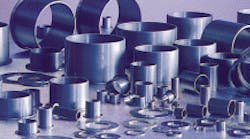Authored by: |
Sometimes, thicker is better — heavy wool socks on a cold day or a thick, juicy steak for dinner come to mind. However, when it comes to plain bushings, thick walled isn’t necessarily better than thin-walled versions.
First, it’s important to understand the basic difference between a thin-walled plastic bushing and a thick-walled bronze bushing. The wall thicknesses of standard bronze bushings range between 0.0625 and 0.156 in. In comparison, plastic bushings have walls typically from 0.0468 to 0.0625-in. thick.
Thin walls offer some advantages that let plastic bushings perform as well as, if not better than, thick-walled bushings. For example, thinner walls are better for heat dissipation. Heat buildup can accelerate wear on a bushing, so it is critical that heat dissipates through the shaft and housing. With thick-walled bronze bushings, heat buildup is much more likely.
Better heat dissipation equates to higher PV (pressure-velocity) values — a measure of performance capability. Higher PV ratings let bushings handle higher speeds and loads.
In addition, thin-walled plastic bushings can hold tighter tolerances and are less likely to deform, which can be common with thicker-walled bushings. Finally, thin-walled plastic bushings are well suited for applications where weight and fuel economy are an issue. Typical examples include racing bikes, snowmobiles, automobiles, and motorcycles. (The accompanying graph compares the weights of different bushing materials.)
Common misconceptions
Despite the performance advantages, several misconceptions may prevent engineers from taking full advantage of the benefits of thin-walled bushings:
1. Durability. One misconception is that thin-walled plastic bushings are not as strong or durable as thick-walled bronze bushings. It is important to remember that the wall thickness of either bushing does not directly correlate to its strength. Other more-important factors engineers should take into consideration include the bushing’s weight, coefficient of friction, and wear resistance.
2. Surface pressure. Another mistake is to assume the thin wall of press-fit plastic bushings will affect the surface pressure. Actually, the surface pressure of a press-fit bushing, typically rated in pounds per square inch (psi), is determined by the load divided by the surface area it acts on:
Ps = L/(D × l)
where Ps = surface pressure, psi; L = load, lb; D = inside diameter, in.; and l = bushing length, in. Whether one is using a thin-walled plastic bushing or a thick-walled bronze bushing, wall thickness has no bearing on surface pressure.
3. Life. A third misconception is that thin-walled plastic bushings have shorter lives than their thick-walled bronze counterparts. It seems reasonable to assume that because a plastic bushing has a thinner wall and less material, it will not last as long as a thick-walled bronze bushing. But it’s wrong. The thin wall of a plastic bushing better dissipates heat, which helps slow wear.
Bronze bushings are designed with thicker walls to compensate for wear. But even with the added material, the bushing surface still wears under certain conditions. In high-rotation applications, continually relubricating the bushing helps prevent this wear. But if a bronze bushing sees other types of motion, such as low-speed rotation or back-and-forth oscillation, it may experience inordinate wear that increases clearance between the shaft and bearing. This, in turn, can lead to a number of problems, such as a loss of accuracy, higher friction, excessive noise, and premature failure.
It is important to remember that wear depends on the bushing material and not wall thickness. And keep in mind that leading manufacturers are constantly developing new plastic formulations which minimize wear and provide long-lasting, maintenance-free operation.
